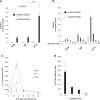Activation of RHOA-VAV1 signaling in angioimmunoblastic T-cell lymphoma
- PMID: 28832024
- PMCID: PMC5843900
- DOI: 10.1038/leu.2017.273
Activation of RHOA-VAV1 signaling in angioimmunoblastic T-cell lymphoma
Abstract
Somatic G17V RHOA mutations were found in 50-70% of angioimmunoblastic T-cell lymphoma (AITL). The mutant RHOA lacks GTP binding capacity, suggesting defects in the classical RHOA signaling. Here, we discovered the novel function of the G17V RHOA: VAV1 was identified as a G17V RHOA-specific binding partner via high-throughput screening. We found that binding of G17V RHOA to VAV1 augmented its adaptor function through phosphorylation of 174Tyr, resulting in acceleration of T-cell receptor (TCR) signaling. Enrichment of cytokine and chemokine-related pathways was also evident by the expression of G17V RHOA. We further identified VAV1 mutations and a new translocation, VAV1-STAP2, in seven of the 85 RHOA mutation-negative samples (8.2%), whereas none of the 41 RHOA mutation-positive samples exhibited VAV1 mutations. Augmentation of 174Tyr phosphorylation was also demonstrated in VAV1-STAP2. Dasatinib, a multikinase inhibitor, efficiently blocked the accelerated VAV1 phosphorylation and the associating TCR signaling by both G17V RHOA and VAV1-STAP2 expression. Phospho-VAV1 staining was demonstrated in the clinical specimens harboring G17V RHOA and VAV1 mutations at a higher frequency than those without. Our findings indicate that the G17V RHOA-VAV1 axis may provide a new therapeutic target in AITL.
Conflict of interest statement
SC received research funding from Bristol-Meyer Squibb that markets dasatinib.
Figures








References
-
- de Leval L, Gisselbrecht C, Gaulard P. Advances in the understanding and management of angioimmunoblastic T-cell lymphoma. Br J Haematol 2010; 148: 673–689. - PubMed
-
- Sakata-Yanagimoto M, Enami T, Yoshida K, Shiraishi Y, Ishii R, Miyake Y et al. Somatic RHOA mutation in angioimmunoblastic T cell lymphoma. Nat Genet 2014; 46: 171–175. - PubMed
-
- Yoo HY, Sung MK, Lee SH, Kim S, Lee H, Park S et al. A recurrent inactivating mutation in RHOA GTPase in angioimmunoblastic T cell lymphoma. Nat Genet 2014; 46: 371–375. - PubMed
Publication types
MeSH terms
Substances
Grants and funding
LinkOut - more resources
Full Text Sources
Other Literature Sources
Molecular Biology Databases
Miscellaneous

